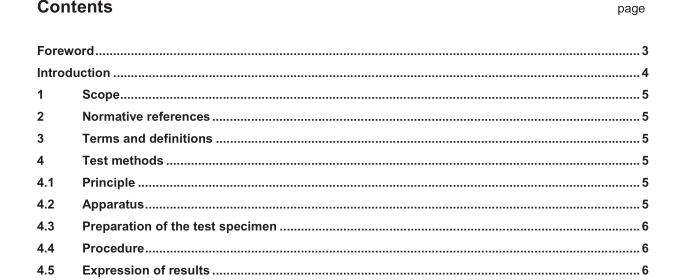EN 14691:2005 – Flexible sheets for waterproofing – Waterproofing of concrete bridge decks and other concrete surfaces trafficable by vehicles – Compatibility by heat conditioning

1 Scope
This European Standard specifies a test method for the evaluation of the compatibility of the waterproofing system applied to a concrete surface and covered with an asphalt layer. The complete system is exposed to an accelerated heat conditioning followed by a determination of the shear strength properties before and after heat conditioning.
2 Normative references
The following referenced documents are indispensable for the application of this document. For dated references, only the edition cited applies. For undated references, the latest edition of the referenced document (including any amendments) applies.
EN 13375:2004, Flexible sheets for waterproofing – Waterproofing of concrete bridge decks and other concrete surfaces trafficable by vehicles – Specimen preparation
EN 13416:2001, Flexible sheets for waterproofing — Bitumen, plastic and rubber sheets for roof waterproofing — Rules for sampling
EN 13653, Flexible sheets for waterproofing – Waterproofing of concrete bridge decks and other concrete surfaces trafficable by vehicles – Determination of shear strength
prEN 14695:2003, Flexible sheets for waterproofing — Reinforced bitumen sheets for waterproofing of concrete bridge decks and other concrete surfaces trafficable by vehicles — Definitions and characteristics
3 Terms and definitions
For the purposes of this European Standard, the terms and definitions given in EN 13416:2001,EN 13375:2004, prEN 14695:2003, and the following apply.
heat conditioning
process whereby the test specimen is held at an elevated temperature for a specified period of time 4 Test methods
4.1 Principle
To detect by a change of the shear resistance if any changes occur in properties of test specimens hen they are subjected to accelerated heat conditioning. This is achieved by testing a set of test specimens that have been heat conditioned and comparing the results with a reference set of test specimens that have not been heat conditioned.
4.2 Apparatus
a) Oven, with circulating air (without fresh supply), capable of maintaining (50 ± 2) °C.
b) Loading and support device, capable of meeting the requirements set out in EN 13653.
4.3 Preparation of the test specimen Prepare the test specimens (Type 3) in accordance with EN 13375 for the test method according to EN 13653, and cool to room temperature. Four test specimens are used for the heat conditioning, and four reference test specimens are used for comparison.
4.4 Procedure
4.4.1 Condition the four reference test specimens at (23 ± 2) °C for at least 24 h prior to them being tested in accordance with EN 13653.
4.4.2 Place the remaining four test specimens horizontally in an air-circulating oven in such a way as to allow free movement of air over and around the test specimen. Maintain the temperature in the oven at (50 ± 2) °C. Ensure that the test specimens are not stacked on top of each other.
4.4.3 Remove the test specimens from the oven after a period of 91 days, and allow to condition at (23 ± 2) °C for 24 h prior to being tested for shear strength in accordance with EN 13653.
4.4.4 Before and after the test for shear strength, visually inspect the test specimens for evidence of migration and separation of component layers.
EN 14691:2005 – Flexible sheets for waterproofing – Waterproofing of concrete bridge decks and other concrete surfaces trafficable by vehicles – Compatibility by heat conditioning